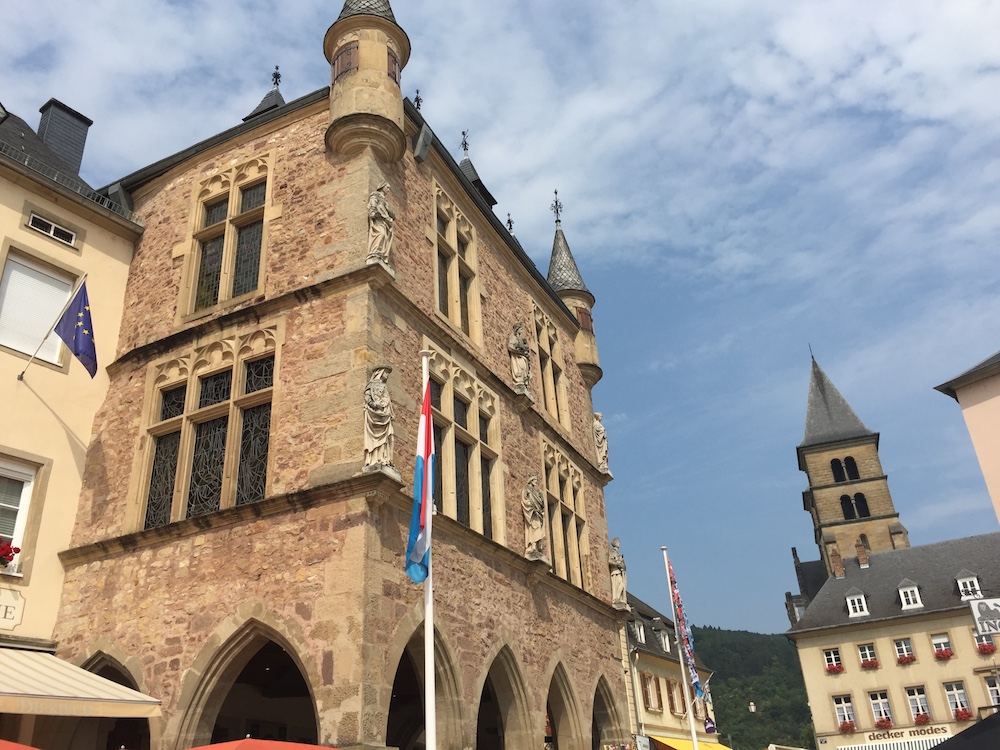Plans to visit the picturesque castle that stands on a bluff overlooking the village of Vianden in rural Luxembourg were scuppered by that old favourite of a British weekend, railway engineering works.
So we found ourselves in the city’s central station trying to work out what to do with our Sunday. I didn’t want to hang around for long either because, like many station districts around the world, it was grim, seedy and architecturally drab. Homeless folk shared the pavements with dirty pigeons and scammers looking for a gullible tourist, and we had to dodge pools of vomit as we went in search of tickets and inspiration. Oh, the glamour…

A short consultation with our Lonely Planet guide made us plump for the town of Echternach in the east of Luxembourg on the border with Germany. So we boarded the 111 bus and rode the hills and valleys of the country, through forests and fields and charming villages that were litter-free and spick and span. Civic pride clearly means much in Luxembourg.
The little village of Hersberg was a particular surprise, hidden in a hollow with a mix of beautiful old and strikingly new architecture, and a romantically tiny chapel on its outskirts. Closer to our destination we drove through the forests, cliffs and rocky countryside of the Mullerthal region, famous for its hiking. Luxembourg, if nothing else, was proving to be a country with plenty of variety in its landscapes despite its humble acreage.

Echternach was billed as one of Luxembourg’s prettiest towns in the Lonely Planet guide but getting off the bus was a bit of a shock. The pedestrianised Rue de la Gare was a throbbing mass of visitors, townsfolk, stalls and tourist tat. The bars looked cheap, many of the people even cheaper. I wasn’t impressed. We walked up the street to the main square, where another market of sorts was being held and music blared inappropriately. It didn’t quite take the edge off of what was a charming town centre, populated by stately and colourful shops, houses, bars and restaurants.
The stand-out building is the old courthouse, parts of which date from the 14th century. It’s been much added to since and most of the gothic embellishments date from the 19th century. We had lunch in a restaurant nearby and the sun gradually burned through the clouds.

Nextdoor stood the the immense Basilica of St Willibrord, named after a Bishop of Utrecht who’d established an abbey on the site as far back as 698. He’s the patron saint of Luxembourg but was actually born in Northumbria back in England. The basilica is vast and gloomy, Romanesque in style but largely a modern recreation thanks to the damage inflicted on the building in the Second World War. The remains of the saint lie in the crypt, in an old stone coffin surrounded by fancy marble casing, but we didn’t hang about because the incense and the Catholic gloom was just too oppressive.

Later we walked out of town along the Rue des Romains, a pretty, quiet street notable for its avenue of trees, grand homes and a slow-moving stream. Our first stop was the remains of a 1st century Roman villa. There’s precious little left of it other than an outline but one thing is clear – the villa was huge. Some say it was the largest Roman villa north of the Alps and at one time it may have had upward of 70 rooms. A little museum provided some context and models of what it might have looked like but ultimately the site was a piece of flat ground with very little going for it.
There’s a lake nearby but the rich, former residents of the villa wouldn’t recognise it for the Meer van Echternach is recent and man-made, if no less perfect for it. We did the circuit, along with plenty of locals and visitors out enjoying the sunshine. Swathes of wild flowers and sunflowers lined the bank, while wooded hills in the distance provided a delightful backdrop.

It was all very charming but my legs ached so back in town we stopped, inexplicably, for a beer in a hideous bar on the Rue de la Gare called, if you can believe it, ‘Virus’. The staff were as indifferent as the name is vile, and then the bus home was delayed so we hung around the bus station looking bored. Nearby stood a memorial to the American forces who’d fought hard to drive the Germans out of the district during the Battle of the Bulge. While the city of Luxembourg didn’t suffer too much damage in the war, it was clear that Echternach had been in the thick of fierce fighting and had endured much as a result.
In the evening, back in the capital, we walked downhill to the picturesque Grund district for food and drink but it was desperately quiet. True, it was Sunday but I expected a bit more life. We stopped at Scott’s bar down by the river and had a beer before discovering that the only restaurant open and worth stopping at was full, so we had to trudge back up that bloody hill again to find somewhere else.

The Place d’Armes was busy and far too touristy but we parked ourselves there at the Cafe Francais, shaded by trees in the square, and had an average Wiener schnitzel. A good sax combo entertained the square’s diners and drinkers.
Being creatures of habit and wanting to go somewhere a bit more sophisticated, we ended up back at Go Ten bar by the palace for the final beers of the evening. And those Simons Pils went down very well indeed.

